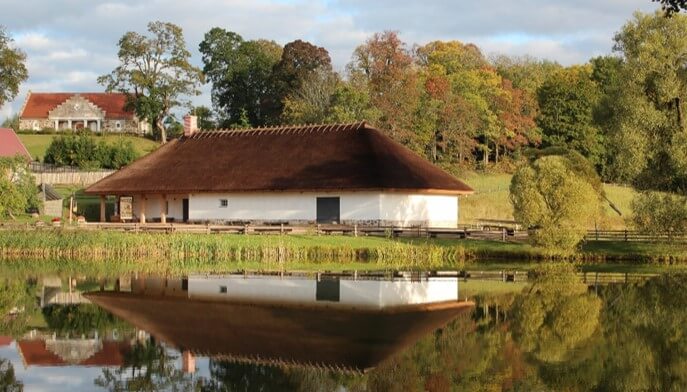This website uses cookies so that we can provide you with the best user experience possible. Cookie information is stored in your browser and performs functions such as recognising you when you return to our website and helping our team to understand which sections of the website you find most interesting and useful.
Turaida Historical Centre

The EHL Site
The Historical Centre of Turaida, a cultural heritage site spanning 57.86 hectares, encapsulates a thousand years of history. Established in 1988, the Turaida Museum Reserve safeguards and celebrates this cultural and natural legacy, granted the status of Specially Protected Cultural Monument in 1994. It’s the only site of its kind in Latvia. The Centre’s significance within Latvian and European contexts is unveiled through five thematic complexes:
Folk Song Park
A unique exhibition blending natural and man-made objects, showcasing 26 sculptures by Indulis Ranka. These sculptures, housed in the “Folk Song Hill” and “Song Garden,” reflect the wisdom and values encapsulated in folk songs. The park, opened in 1985, is dedicated to Krišjānis Barons, a renowned collector of Latvian folk songs.
Heritage of the Gauja Livs
The Livs, Latvia’s second indigenous people, have almost vanished. Their heritage, reflected in the environment and exhibition, traces back to the 12th century when the Gauja Livs inhabited parts of the Gauja River. They’ve significantly contributed to the Latvian cultural area.
Turaida Medieval Stone Castle
Built in 1214, the stone castle was the residence of the Archbishop of Riga from the 13th to the 16th century. It evidences the integration of Christianity into the region and is the most archaeologically investigated medieval castle in the Baltics.
Turaida Wooden Church and Church Hill
Constructed in 1750, the church is one of Latvia’s oldest wooden churches. Nearby is the Church Hill cemetery, featuring a memorial to Maija, the Rose of Turaida, a symbol of faithful love and the inception of women’s rights in 17th century Europe.
Economic Centre of the Turaida Estate
Comprising 21 historic buildings, the exhibitions tell the story of the estate’s management and economic life, the emancipation of peasants, and the social hierarchy and change towards democracy.
The Turaida Museum Reserve offers a synergy of environmental and museum values, highlighting the cultural landscape’s significance in history. The Historical Centre of Turaida embodies typical features of cultural and historical centres in Latvia, with the added allure of its location on the banks of the ancient Gauja River Valley, within the Gau
European dimension
The Historical Centre of Turaida is a place that represents the interaction of different cultures and a multi-faceted process of Europeanisation over a thousand-year period. It is a place that expressed non-violent resistance in the “Singing Revolution”, bringing to life the values of freedom, democracy and human rights.
The organization
Situated 50 km from Latvia’s capital, Riga, in the Gauja National Park, the Turaida Museum Reserve is a Specially Protected Cultural Monument. This enchanting site, known as the Garden of God in the ancient Liv language, was established in 1988 and covers an area of 57.86 ha housing 39 historic structures. Its rich cultural and historical heritage, picturesque landscapes, and well-maintained environment attract thousands of visitors annually, making it the most visited museum in Latvia.
Since the 18th century, Turaida has been a popular tourist destination, now ranking among Latvia’s top 10 national and international attractions. The museum is also a renowned research and heritage popularization centre.
The Turaida Museum Reserve’s mission is to foster a harmonious society by showcasing the evolution of Latvian wisdom and experience through the natural, cultural, and historical values accumulated over a thousand years, starting from the 11th century.
The museum provides numerous access pathways to the rich heritage of the Turaida Historical Centre, successfully positioning itself as Latvia’s most visited museum. Its thriving partnerships with various governmental and non-governmental organizations, research institutions, and the local community have bolstered its objectives and reputation.
Visitor experience is central to the museum’s activities, with daily services provided without days off and a focus on nurturing reciprocal communication. The museum also values the preservation and popularization of intangible cultural heritage, including traditional crafts.
Exhibitions at the Turaida Museum Reserve narrate the vibrant and dramatic history of the Turaida region, showcasing the continuous shifts and changes over the past millennium. The museum recognizes the global value of the region’s environmental and cultural heritage, hence preserving its diverse heritage and collective Latvian experience to enrich global knowledge.
